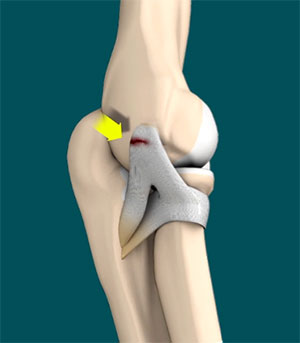
What is the Lateral Ulnar Collateral Ligament (LUCL)?
A ligament is a band of tough fibrous connective tissue around a joint. It attaches bone to bone and supports and holds them together.
Your elbow is held in place with the help of several ligaments. The main stabilizing ligament on the outside of the elbow is the lateral ulnar collateral ligament (LUCL).
A LUCL injury is a condition where the ligament is extremely stretched, torn or detached from the elbow joint.
Causes of LUCL Injuries
LUCL injuries are mostly caused by a traumatic dislocation of the elbow joint. Minor injuries or chronic conditions that cause insufficiency of the lateral elbow ligament complex can also lead to LUCL injury.
Symptoms
Pain in the elbow is the primary symptom of LUCL injuries. Other symptoms can be:
- A sensation of the elbow sliding out of place
- A feeling of clicking or popping with elbow extension and/or forearm rotation
- Clunking or catching when pushing off from a chair arm
Diagnosis
LUCL injuries are typically diagnosed using various methods such as:
- Physical exam with palpation (check for tenderness over LUCL)
- Motion and stability testing of the elbow (varus instability)
- Chair rise test, floor push-up test, table-top relocation test
- Radiograph (X-ray) or MRI
What are the Nonoperative Options?
In the acute setting after an injury, rest, activity modification and immobilization of the elbow may be necessary to allow the ligament to heal. Physical therapy to strengthen the muscles around the elbow can also be used to assist with elbow stability.
What are the Operative Options?
The operative options include:
- LUCL repair
- LUCL reconstruction (allograft or autograft)
What Happens After Your Surgery?
After the surgery, your elbow may be put into a splint for 7-10 days.
Your Rehabilitation
Once the splint is removed, your rehabilitation process begins with controlled motion of the elbow. A removable thermoplastic splint may be needed to continue protecting the elbow while therapy is initiated.
Thereafter, the focus will be shifted toward strengthening the elbow flexors, extensors, pronators, and supinators. The rehabilitation process may continue until you resume full activity, which may take 4 to 6 months after your surgery.
Related Topics
- Triceps Injuries
- Osteochondritis Dissecans of the Capitellum
- Elbow Trauma
- Elbow Arthritis
- Bicep Tendon Tear at the Elbow
- Elbow Dislocation
- Triceps Tendonitis
- Elbow (Olecranon) Bursitis
- Elbow Sprain
- Tennis Elbow
- Golfer's Elbow
- Little League Elbow
- Nursemaid's Elbow
- Elbow Pain
- Elbow Contracture
- Distal Humerus Fractures of the Elbow
- Radial Head Fractures of the Elbow
- Elbow Fractures
- Ulnar Nerve Neuropathy
- Loose Bodies in the Elbow
- Radial Tunnel Syndrome
- Lateral Ulnar Collateral Ligament Injuries (Elbow)
- Post-traumatic Stiffness (Elbow)
- Cubital Tunnel Syndrome (Ulnar Nerve Entrapment)





